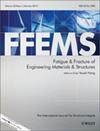A Novel Method for Estimating Fatigue Properties of Plain Weave Composites Under Nonstationary Random Loads Based on Residual Strength
Abstract
In practical fatigue scenarios, certain fatigue processes exhibit nonstationary characteristics rather than stationary ones. This paper presents a novel approach for estimating fatigue properties of composite materials under nonstationary stochastic loads, leveraging a fusion of time-domain and frequency-domain analyses to capitalize on their respective strengths. By introducing the evolutionary power spectrum, the residual strength combining frequency-domain analysis method extends its application from stationary random processes to nonstationary ones. This method derives the integral equation of residual strength under nonstationary random loads and solves it using a differential method. This method requires only the S-N curve under a specific stress ratio and the corresponding residual strength degradation law for life prediction. To improve the generality of the model, fatigue tests at multiple stress ratios were conducted in this study to construct a constant life diagram (CLD), from which S-N curve parameters at arbitrary stress ratios can be interpolated. This approach not only reduces computational complexity but also yields reliable results. Furthermore, it considers both the randomness of the load and the dispersion of the composite material, allowing for the prediction of failure probability under nonstationary random conditions. Fatigue tests under two types of nonstationary random loads were obtained. The prediction results are basically within 1.5 times the error range.

 求助内容:
求助内容: 应助结果提醒方式:
应助结果提醒方式:


